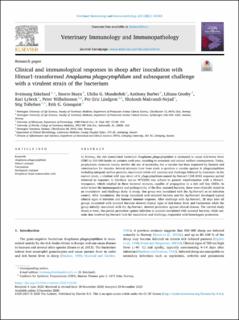| dc.description.abstract | In Norway, the tick-transmitted bacterium Anaplasma phagocytophilum is estimated to cause tick-borne fever (TBF) in 300 000 lambs on pastures each year, resulting in economic and animal welfare consequences. Today, prophylactic measures mainly involve the use of acaricides, but a vaccine has been requested by farmers and veterinarians for decades. Several attempts have been made to produce a vaccine against A. phagocytophilum including antigenic surface proteins, inactivated whole cell vaccines and challenge followed by treatment. In the current study, a virulent wild type strain of A. phagocytophilum named Ap.Norvar1 (16S rRNA sequence partial identical to sequence in GenBank acc.no M73220) was subject to genetic transformation with a Himar1-transposon, which resulted in three bacterial mutants, capable of propagation in a tick cell line (ISE6). In order to test the immunogenicity and pathogenicity of the live, mutated bacteria, these were clinically tested in an inoculation- and challenge study in sheep. One group was inoculated with the Ap.Norvar1 as an infection control. After inoculation, the sheep inoculated with mutated bacteria and the Ap.Norvar1 developed typical clinical signs of infection and humoral immune response. After challenge with Ap.Norvar1, 28 days later all groups inoculated with mutated bacteria showed clinical signs of tick-borne fever and bacteremia while the group initially inoculated with the Ap.Norvar1, showed protection against clinical disease. The current study shows a weak, but partial protection against infection in animals inoculated with mutated bacteria, while animals that received Ap.Norvar1 both for inoculation and challenge, responded with homologues protection. | |
